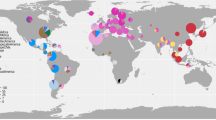Abstract
Genetic variation among strains of Helicobacter pylori is high and the population structure non-clonal. The infection historically has been associated with overt clinical outcomes that, for severity, range from chronic active gastritis to peptic ulcer disease and from MALT (mucosa-associated lymphoid tissue) lymphoma to distal gastric adenocarcinoma1. Assuming that a large fraction of the reshuffled bacterial genes has no relevance for pathology, scientists have tried to reduce the whole to a set of genes associated with virulence. This follows more than a decade of elegant studies on bacterial pathogenesis where pathogens always clustered and separate from non-pathogens and pulses of genetic information segregate with the virulent variants. Helicobacter diversity has been explored by RAPD (random amplification of polymorphic DNA), DNA fingerprinting, multilocus enzyme electrophoresis and by genetic mapping with pulsed-field gel electrophoresis2–4. All these approaches lead to the conclusion that mutations are frequent and that single genes or operons are scrambled. This is in contrast with the relative genetic stability after repeated passages in vitro and with the observation that, with families with a history of high incidence of H. pylori infections, the strains are highly homogeneous.
Access this chapter
Tax calculation will be finalised at checkout
Purchases are for personal use only
Preview
Unable to display preview. Download preview PDF.
Similar content being viewed by others
References
Parsonnet J, Friedman GD, Orentreich N, Vogelman H. Risk for gastric cancer in people with CagA positive or CagA negative Helicobacter pylori infection. Gut. 1997;40:297–301.
Go MF, Kapur V, Graham DY, Musser JM. Population genetic analysis of Helicobacter pylori by multilocus enzyme electrophoresis: extensive allelic diversity and recombinational population structure. J Bacteriol. 1996;178:3934–8.
Akopyanz N, Bukanov NO, Westblom TU, Berg DE. PCR-based RFLP analysis of DNA sequence diversity in the gastric pathogen Helicobacter pylori. Nucl Acids Res. 1992;20:6221–5.
Jiang Q, Hiratsuka K, Taylor DE. Variability of gene order in different Helicobacter pylori strains contributes to genome diversity. Mol Microbiol. 1996;20:833–42.
Telford JL, Covacci A, Rappuoli R, Chiara P. Immunobiology of Helicobacter pylori infection. Curr Opin Immunol. 1997;9:498–503.
Hazell SL, Andrews RH, Mitchell HM, Daskalopoulous G. Genetic relationship among isolates of Helicobacter pylori: evidence for the existence of a Helicobacter pylori species-complex. FEMS Microbiol Lett. 1997;150:27–32.
Xiang Z, Censini S, Bayeli PF et al. Analysis of expression of CagA and VacA virulence factors in 43 strains of Helicobacter pylori reveals that clinical isolates can be divided into two major types and that CagA is not necessary for expression of the vacuolating cytotoxin. Infect Immun. 1995;63:94–8.
Molinari M, Galli C, Norais N et al. Vacuoles induced by Helicobacter pylori toxin contain both late endosomal and lysosomal markers. J Biol Chem. 1997;272:25339–44.
Ito Y, Azuma T, Ito S et al. Analysis and typing of the vacA gene from cagA-positive strains of Helicobacter pylori isolated in Japan. J Clin Microbiol. 1997;35:1710–14.
Papini E, Satin B, Bucci C et al. The small GTP binding protein rab7 is essential for cellular vacuolation induced by Helicobacter pylori cytotoxin. EMBO J. 1997;16:15–24.
Atherton JC, Peek RM Jr, Tham KT, Cover TL, Blaser MJ. Clinical and pathological importance of heterogeneity in vacA, the vacuolating cytotoxin gene of Helicobacter pylori. Gastroenterology. 1997;112:92–9.
Censini S, Lange C, Xiang Z et al. cag, a pathogenicity island of Helicobacter pylori, encodes type I-specific and disease-associated virulence factors. Proc Natl Acad Sci USA. 1996; 93:14648–53.
Hacker J, Blum-Oehler G, Muhldorfer I, Tschape H. Pathogenicity islands of virulent bacteria: structure, function and impact on microbial evolution. Mol Microbiol. 1997;23:1089–97.
Waldor MK, Mekalanos JJ. Lysogenic conversion by a filamentous phage encoding cholera toxin. Science. 1996;272:1910–14.
Lee CA. Type III secretion systems: machines to deliver bacterial proteins into eukaryotic cells? Trends Microbiol. 1997;5:148–56.
Lee CA. Pathogenicity islands and the evolution of bacterial pathogens. Infect Agents Dis. 1996;5:1–7.
Covacci A, Falkow S, Berg DE, Rappuoli R. Did the inheritance of a pathogenicity island modify the virulence of Helicobacter pylori? Trends Microbiol. 1997;5:205–8.
Salmond GP. Pili, peptidases and protein secretion: curious connections. Trends Microbiol. 1996;4:474–6.
Covacci A, Rappuoli R. Pertussis toxin export requires accessory genes located downstream from the pertussis toxin operon. Mol Microbiol. 1993;8:429–34.
Weiss AA, Johnson FD, Burns DL. Molecular characterization of an operon required for pertussis toxin secretion. Proc Natl Acad Sci USA. 1993;90:2970–4.
Baker B, Zambryski P, Staskawicz B, Dinesh-Kumar SP. Signaling in plant-microbe interactions. Science. 1997;276:726–33.
Christie PJ. Agrobacterium tumefaciens T-complex transport apparatus: a paradigm for a new family of multifunctional transporters in eubacteria. J Bacteriol. 1997;179:3085–94.
Fullner KJ, Lara JC, Nester EW. Pilus assembly by Agrobacterium T-DNA transfer genes. Science. 1996;273:1107–9.
Pohlman RF, Genetti HD, Winans SC. Common ancestry between IncN conjugal transfer genes and macromolecular export systems of plant and animal pathogens. Mol Microbiol. 1994;14:655–68.
Winans SC, Burns DL, Christie PJ. Adaptation of a conjugal transfer system for the export of pathogenic macromolecules. Trends Microbiol. 1996;4:64–8.
Segal ED, Lange C, Covacci A, Tompkins LS, Falkow S. Induction of host signal transduction pathways by Helicobacter pylori. Proc Natl Acad Sci USA. 1997;94:7595–9.
Atherton JC, Tham KT, Peek RM Jr, Cover TL, Blaser MJ. Density of Helicobacter pylori infection in vivo as assessed by quantitative culture and histology. J Infect Dis. 1996;174:552–6.
Tomb JF, White O, Kerlavage AR et al. The complete genome sequence of the gastric pathogen Helicobacter pylori. Nature. 1997;388:539–47.
Editor information
Editors and Affiliations
Rights and permissions
Copyright information
© 1998 Springer Science+Business Media Dordrecht
About this chapter
Cite this chapter
Covacci, A. et al. (1998). The origin of virulence in type I strains of Helicobacter pylori . In: Hunt, R.H., Tytgat, G.N.J. (eds) Helicobacter pylori. Springer, Dordrecht. https://doi.org/10.1007/978-94-011-4882-5_2
Download citation
DOI: https://doi.org/10.1007/978-94-011-4882-5_2
Publisher Name: Springer, Dordrecht
Print ISBN: 978-94-010-6046-2
Online ISBN: 978-94-011-4882-5
eBook Packages: Springer Book Archive




